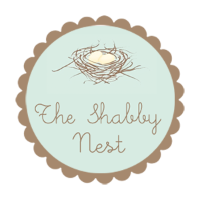Here are three that are currently adorning my front porch for the Halloween/ fall season.
The front porch still needs some more sprucing up but that's a'comin shortly with some punkins and corn stalks my friends...
So, here's what you'll need:
- A bleached canvas drop cloth (read my post HERE on how to prepare the drop cloth if you haven't already read it)
- Freezer paper (wax or parchment paper won't work... I tried and it failed miserably)
- a sharp razor blade or exacto knife
- spray paint in the color(s) of your choice
Here's how it's done:
First, you need to create your envelope pillow cover. Please proceed into this next section with caution. When I sew, I typically just wing things. I didn't follow an exact template or cut each piece the same every time. Using another pillow cover as my guide, I cut a piece of drop cloth to be the width of the pillow I was covering plus approx. 2 inches by the length of the pillow x 2.5. Sooooo, if the pillow you are covering is 20" x 20", your fabric needs to be 22" wide x 50" long... make sense?
Hem each short end of your fabric under.
I prefer to quickly sew mine, but you can also use stitch witchery if you prefer. With this product, you cut the stitch witchery to the length of the area you wish to seam together, and then iron the two folds together.
Honestly, it took me longer and didn't look as nice with the stitch witchery. I'll let you decide, my friends. :)
So at this point you should have two hemmed edges (on the shorter ends of your fabric). Lay the fabric down, right side up facing you (so that the hemmed edges are facing the ground). Fold one side over approx 1/3" of the width of your final pillow. For a 20" pillow for example, I folded one side in about 7".
Next, fold the second side over the top of your first fold to equal the desired length of your pillow (20" in my case).
 |
| see my cute new birthday present peeping out??? |
If you're feeling really wild, you can even surge the edges at this point. :) It was 2 am for me and I was too tired so one quick stitch worked just dandy for me.
Fold the pillow cover inside out and viola! You should have a nice little envelope cover that doesn't require any zipper, buttons, or ties.
Now, onto the fun part. Using freezer paper, I created my own stencils by tracing images/ other fabric prints and then used a sharp razor blade to cut out the parts I wanted colored.
I traced the chevron pattern from my curtains for one, a black crow from THIS Tag Halloween doormat, and then some leaf stencils for the last one. If you have a cricuit or similar machine, this would be a FABULOUS time to whip it out and save yourself a lot of time.
Next, place the freezer paper carefully on your pillow cover where you want the images to be placed, shiny side down. With your iron on medium to high heat (mine is old and ghetto so the hottest temp is perfect), iron the paper onto your fabric, paying careful attention to the cutout sections making sure that the freezer paper sticks well. If you are lazy here, your paint will bleed through. Trust me on this one. I learned the hard way. :)
Finally, cover all of the exposed parts of your fabric that you don't want painted and lightly spray paint over your stencils. My paint never bled through the fabric, but you may want to put a piece of cardboard or thick cardstock inside the cover to prevent the paint from bleeding through the back side. Remember not to over saturate the painted area. It will not appear to be a very deep color when painted onto the nubby canvas material, but it will pop plenty once you remove the stencil.
 |
| the color I used for the rust orange is called Cinnamon by Rustoleum. I loved it |
Allow the paint to dry for at least 10 minutes, then remove your stencil and once again, VIOLA!
I was skeptical at first with the idea of spray paint on pillows but I can assure you that they look and feel fabulous. It isn't scratchy, and the paint doesn't rub off at all. The canvas material is already nubby and natural feeling, so it works perfectly. You can also use this to create indoor pillows with some fun geometrical shapes or text. I created this cute little turquoise pillow and my & pillow using the same technique.
Kind of fun, right? To care for these pillow covers, turn them inside out before putting them on a gentle cycle in the washing machine, and then allow them to air dry. I'm not so sure how well an iron would work with the paint, so I plan to avoid it all together.Do you spy my new curtains in the background??? As you can see, I went with my first fabric choice and am SO glad I did. I will do a separate post on them soon. With my curtains sewn and my new rug that my sweets gave me for my bday, my family room is finally starting to feel like my style. I can't wait for it all to be finished.
Also, to end on a sappy note I just have to share the very best part about my birthday this year. My darling hubby told me (sincerely) that he married me because I make him a better person. It wasn't a compliment I was seeking for, and he wasn't expecting anything in return (wink wink); he genuinely meant it. Man, I love that man.
thanks for reading, my friends...
XO
~One-year-older-but-not-much-wiser- Penny Wenny
I'm sharing this tute with the following fabulous parties. Check them out!






































































































